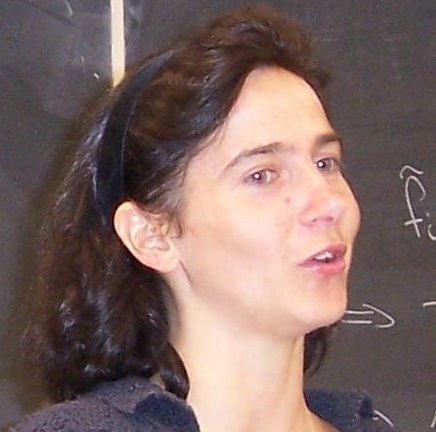6.E: Ejercicios para el Capítulo 6
- Page ID
- 115074
{{Template.dropdown {ruta:” /álgebra/linear_álgebra "}}}
Ejercicios de cálculo
1. Definir el mapa\(T: \mathbb{R}^2 \to \mathbb{R}^2\) por\(T(x,y)=(x+y,x)\).
- Mostrar que\(T\) es lineal.
- Demostrar que\(T\) es suryectiva.
- Encuentra\(\dim\left(\text{null}\left(T\right)\right)\).
- Encontrar la matriz para\(T\) con respecto a la base canónica de\(\mathbb{R}^2\).
- Encontrar la matriz para\(T\) con respecto a la base canónica para el dominio\(\mathbb{R}^2\) y la base\(((1,1),(1,-1))\) para el espacio objetivo\(\mathbb{R}^2\).
- Mostrar que el mapa\(F:\mathbb{R}^2 \to \mathbb{R}^2\) dado por no\(F(x,y)=(x+y,x+1)\) es lineal.
2. Dejar\(T\in\mathcal{L}(\mathbb{R}^2)\) ser definido por
\[ T\begin{pmatrix} x\\ y\end{pmatrix} = \begin{pmatrix}y\\ -x\end{pmatrix},\quad \mbox{ for all } \begin{pmatrix}x\\ y\end{pmatrix}\in \mathbb{R}^2.\]
- Demostrar que\(T\) es suryectiva.
- Encuentra\(\dim\left(\text{null}\left(T\right)\right)\).
- Encontrar la matriz para\(T\) con respecto a la base canónica de\(\mathbb{R}^2\).
- Mostrar que el mapa\(F:\mathbb{R}^2 \to \mathbb{R}^2\) dado por no\(F(x,y)=(x+y,x+1)\) es lineal.
3. Considerar los espacios vectoriales complejos\(\mathbb{C}^2\) y\(\mathbb{C}^3\) con sus bases canónicas, y definir\(S \in \mathcal{L}(\mathbb{C}^3,\mathbb{C}^2)\) ser el mapa lineal definido por\(S(v) = A v, \forall v \in \mathbb{C}^{3}\), donde\(A\) is the matrix
\[ A = M(S) = \begin{pmatrix} i &1 &1 \\ 2i& -1& -1 \end{pmatrix} .\]
Encuentre una base para\(null(S).\)
4. Dé un ejemplo de una función\(f: \mathbb{R}^{2} \to \mathbb{R}\) que tiene
la propiedad que
\[ \forall a \in \mathbb{R}, \forall v \in \mathbb{R}^2, f(av) = a f(v) \]
pero tal que no\(f\) es un mapa lineal.
5. Mostrar que el mapa lineal\(T: \mathbb{F}^{4} \to \mathbb{F}^{2}\) es suryectiva si
\[ \mbox{null}(T) = \{(x_{1}, x_{2}, x_{3}, x_{4}) \in \mathbb{F}^{4} \ | \ x_{1} = 5 x_{2}, x_{3} = 7 x_{4} \}. \]
6. Mostrar que ningún mapa lineal\(T: \mathbb{F}^{5} \to \mathbb{F}^{2}\) puede
tener como su espacio nulo el conjunto
\[ \{(x_{1}, x_{2}, x_{3}, x_{4}, x_{5}) \in \mathbb{F}^{5} \ | \ x_{1} = 3 x_{2}, x_{3} = x_{4} = x_{5} \}. \]
7. Describir el conjunto\(x=(x_1,x_2,x_3)\in\mathbb{R}^3\) de soluciones del sistema de ecuaciones
\[ \left. \begin{array}{rl} x_1-x_2+x_3&=0 \\ x_1+2x_2 +x_3&=0 \\ 2x_1+x_2+2x_3&=0 \end{array} \right\}. \]
Ejercicios de prueba de escritura
1. Dejar\(V\) y\(W\) ser espacios vectoriales encima\(\mathbb{F}\) con\(V\) finito-dimensional, y dejar\(U\) ser cualquier
subespacio de\(V\). Dado un mapa lineal\(S \in \cal{L}(U,W),\) demostrar que existe un mapa lineal
\(T \in \cal{L}(V,W)\) tal que, para cada\(u \in U, S(u) = T(u).\)
2. Dejar\(V\) y\(W\) ser espacios vectoriales encima\(\mathbb{F},\) y supongamos que eso\(T \in \cal{L}(V,W)\) es inyectivo.
Dada una lista linealmente independiente\((v_1,\ldots , v_n)\) de vectores en\(V\), demostrar que la
lista\((T(v_1), \ldots ,T(v_n))\) es linealmente independiente en\(W.\)
3. Let\(U, V,\) y\(W\) ser espacios vectoriales sobre\(\mathbb{F},\) y supongamos que los mapas lineales\(S \in \cal{L}(U, V )\)
y\(T \in \cal{L}(V,W)\) son ambos injectivos. Demostrar que el mapa de composición\(T \circ S\) es inyectivo.
4. Dejar\(V\) y\(W\) ser espacios vectoriales sobre\(\mathbb{F},\) y supongamos que eso\(T \in \cal{L}(V,W)\) es suryectiva.
Dada una lista de expansión\((v_1,\ldots , v_n)\) para\(V\), demostrar que
\[span(T(v_1),\ldots ,T(v_n)) = W.\]
5. Dejar\(V\) y\(W\) ser espacios vectoriales sobre\(\mathbb{F}\) con\(V\) dimensiones finitas. Dado\(T \in \cal{L}(V,W),\)
demostrar que hay un subespacio\(U\) de\(V\) tal manera que
\[U \cap null(T) = \{0\} \rm{~and~} range(T) = \{T(u) | u \in U\}.\]
6. Dejar\(V\) ser un espacio vectorial encima\(\mathbb{F},\) y supongamos que hay un mapa lineal\(T \in \cal{L}(V, V )\)
tal que ambos\(null(T)\) y\(range(T)\) son subespacios finito-dimensionales de\(V\).
\(V\)Demostrar que también debe ser finito-dimensional.
7. Dejar\(U, V,\) y\(W\) ser espacios vectoriales finito-dimensionales sobre\(\mathbb{F}\) con\(S \in \cal{L}(U, V )\) y
\(T \in \cal{L}(V,W).\) demostrar que
\[dim(null(T \circ S)) \leq dim(null(T)) + dim(null(S)).\]
8. Dejar\(V\) ser un espacio vectorial finito-dimensional encima\(\mathbb{F}\) con\(S, T \in \cal{L}(V, V).\) Probar que
\(T \circ S\) es invertible si y solo si ambos\(S\) y\(T\) son invertibles.
9. Dejar\(V\) ser un espacio vectorial finito-dimensional sobre\(\mathbb{F}\) con\(S, T \in \cal{L}(V, V ),\) y denotar por
I el mapa de identidad en\(V\). Demostrar que\(T \circ S = I\) si y solo si\(S \circ T = I.\)


